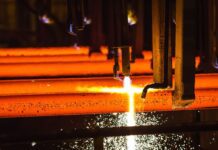
Australia, the world’s largest iron ore exporter, could see its export revenues plummet by 50 per cent unless it makes an urgent shift to green iron production, according to a new report by think tank Climate Energy Finance.
The report, Green Metal Statecraft: Forging Australia’s Green Iron Industry, warns that as global steelmakers transition to low-emission practices, demand for traditional, high-emission iron ore is likely to fall sharply.
This shift could cause Australia’s $138 billion iron ore revenue to halve, affecting the nation’s economy and global market standing.
“Australia has long discussed our nation’s potential to be a renewable energy and zero-emissions trade superpower,” said Tim Buckley, Director of Climate Energy Finance and report co-author.
“But the downside risks of failure to act are profound. Green iron is the single largest investment opportunity for Australia.”
The report stresses that a robust green iron industry could double Australia’s iron ore export value to over $250 billion annually.
However, achieving this would require onshore processing of iron ore using renewable energy before export, leveraging Australia’s world-leading iron ore reserves.
The economic implications extend beyond Australia. With global steelmaking accounting for 6.7 per cent of emissions—over 3.6 billion tonnes per year—switching to green iron could cut global emissions by 1 billion tonnes annually, a figure more than double Australia’s own emissions.
Matt Pollard, lead report author and net zero transformation analyst at Climate Energy Finance, emphasised the urgency of acting now.
“We are now at the precipice of a rapid shift towards decarbonisation in our largest and most profitable export market, with major implications for Australian iron ore exports,” he said.
Pollard also recommended a comprehensive National Green Iron and Steel Strategy, which would include substantial investments in renewable energy, research funding, and collaborative initiatives with Asian partners to facilitate green iron trade.
As highlighted in the report, the stakes are high, with Australia’s leading position in low-cost, high-margin, mid-grade iron ore exports at risk.
“We recommend a National Green Iron and Steel Strategy, with measures such as a $20 billion Future Fund mandate to enable renewable-powered green metal processing and a mandate for collaboration on an Asian Carbon Border Adjustment Mechanism,” Pollard added.
Professor Elizabeth Thurbon, an expert in international political economy from UNSW who authored the report’s foreword, underlined the strategic importance of this transition.
“Australia stands at a nation-defining crossroads with our country’s economic, energy, and environmental security at stake. We can ignore these challenges and suffer a massive hit, or we can confront them head-on and thrive in the global clean economy-in-the-making,” she stated.
Marilyne Crestias, head of Policy & Advocacy at the Clean Energy Investor Group, also weighed in, noting that Australia’s abundance of renewable resources could make it a competitive leader in green iron.
“In the global race to green iron exports, Australia has numerous competitive advantages—such as abundant and cheap renewables—that we must capitalize on. Now is the time to redouble our efforts, and clean energy investors stand ready to enable this transition,” Crestias emphasised.


















